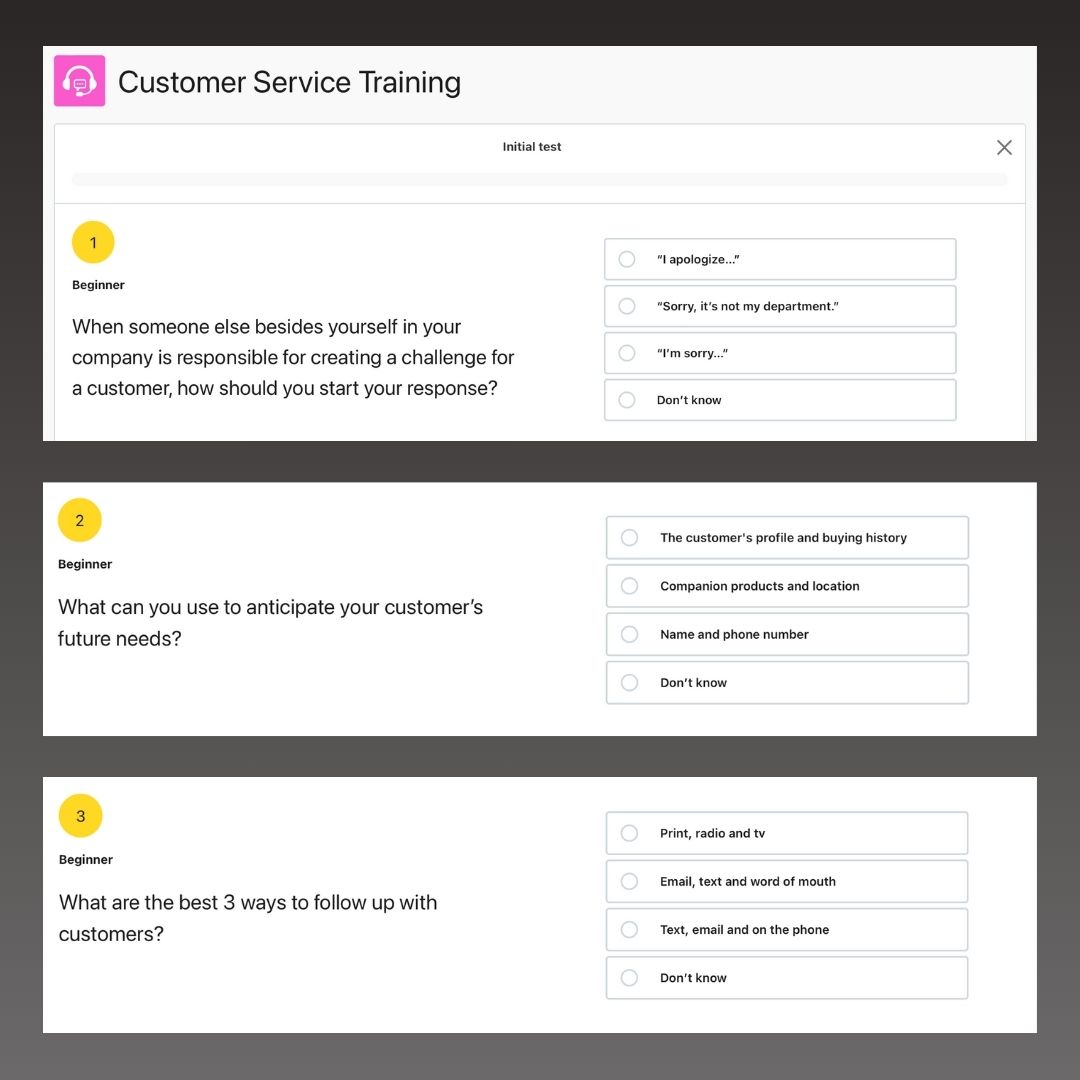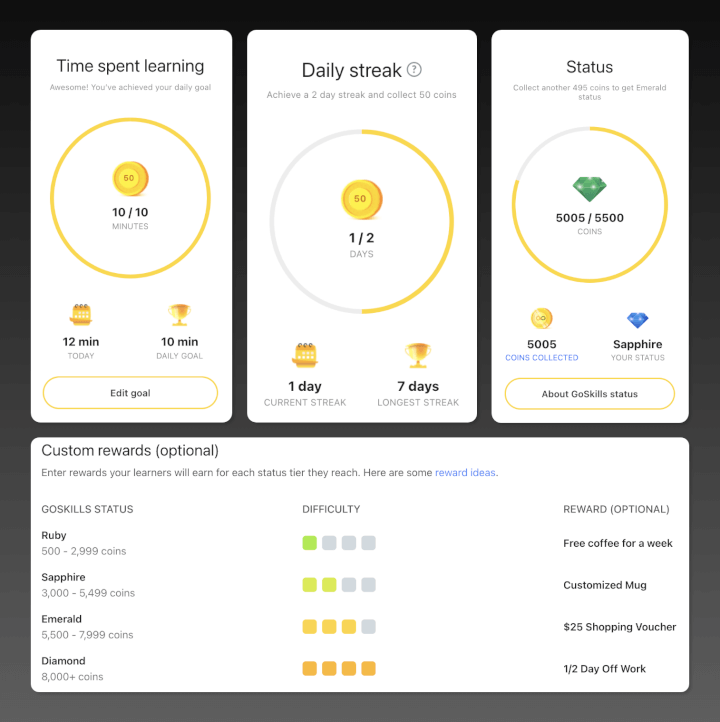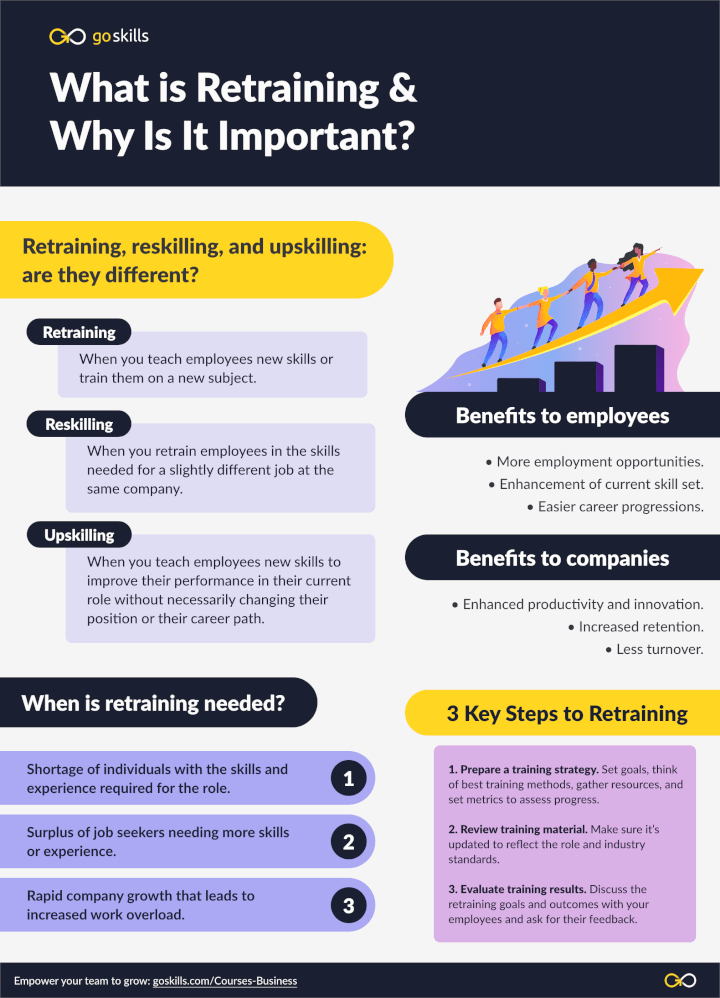In the midst of economic uncertainty, it can be unsettling for employees to figure out what their career prospects look like. In the last few years, companies worldwide have had to let go of thousands of employees in a bid to downsize their workforce and keep their heads above water.
Job retraining is one of the ways those employees can reenter the workforce. Retraining means to train again in a new subject, for a new job, often at a new company or organization. For instance, during the pandemic, tourism workers found themselves without a job due to the circumstances.
Difference between retraining, reskilling and upskilling
While retraining, reskilling, and upskilling are all closely related, they have some key differences:
If you’re retraining people, you’re typically teaching them new skills or are training them on a completely new subject. This could come into play when hiring new people, who have for instance been laid off during the pandemic, for in-demand roles that have opened up or have been newly created at your company. It could be that you’re hiring former hospitality professionals to work as reception staff at your organization.
If you’re reskilling people, you’re likely retraining them in the skills needed for a slightly different job at the same company. Reskilling often happens after redundancy, when organizations want to keep good employees when their current role has become obsolete. Instead of letting them go, they reskill them to put their talent to use somewhere else in the company.
If you’re upskilling people, you’re teaching employees new skills to improve their performance in their current role without necessarily changing their position or career path. This is often the case when employees need to learn about new technologies or software that have been rolled out at their organization.
Why and when should you think about retraining?
Normally when you advertise for a role, you’re aiming to hire someone who already has the skills and experience you need, right? And your needs for hiring are clear: It might be that your organization is getting overwhelmed with customer queries, and you need more staff at your call center or reception to manage the increased workload. Or perhaps you’ve experienced massive growth in the last couple of months (congrats!) and you need to expand your web, marketing or sales team to cater to the growth.
This is where retraining comes in. But why? It is likely that other companies in your industry are experiencing the same influx of calls, or the need to fill extra roles in other departments as soon as possible.
This means most people with the skills specific to your vacant roles are already taken and as a result, you’re finding it difficult to fill the roles. At the same time, there are plenty of people who’ve recently had the unfortunate experience of being laid off in, for instance, the tourism and hospitality industry. They are now looking for work, but they don’t have the right skills or experience for your admin or reception jobs.
What do you do? You hire and retrain them.

Benefits of retraining
Knowledge is the key to success they say. While it may be that the people you’re retraining came to be in that position because of unfortunate circumstances, such as mass layoffs or redundancies, the beauty of jobs is that they don’t (or at least, shouldn't) define people, so people can change tack and learn something different if they need to.
Here are a few of the benefits of employee retraining for both staff and organizations.
Benefits to employees
- Retraining enhances the skill set people already have, even if the job they’re retraining for is vastly different from what they used to do. Not all skills are hard skills, and many of the soft skills needed for different roles are transferable and easily built on.
- Retraining means an opportunity to learn the most in-demand skills and competencies within an industry, which sets them up for easier career progression and future employment opportunities.
- Retraining for a new role, and having the opportunity to learn and develop new skills, can help make people feel more valued and can help give them a new sense of purpose, especially after being laid off or made redundant.
Benefits to organizations
- Having more of your employees up to speed with the latest information and skills needed in your industry, will help produce better products and services, whether it’d be through customer service training or refining processes with innovative ideas.
- Happy and content employees equal less turnover, which can save your organization time and money in the long run.
- While you’re spending time preparing your retraining modules, you’ll be able to evaluate the way your organization goes about processes and perhaps refine those where needed, which can make your organization more efficient, saving time for existing staff as well as those who are being retrained into new roles.
Want to boost your team's success?
Learn why training and development matters (and how to do it right)!
How to retrain your workforce
How do you retrain someone to increase their skill set needed for the vacant roles at your organization? As with any sort of training program, it’s important to have a plan before you start to keep the process efficient and clear and to keep your employees engaged.
1. Define the retraining job and set a budget
In order to keep everyone accountable and on the same page, it’s good practice to define exactly what the retraining will entail, and what the budget will be for it. That way it’s easier to track progress and evaluate the most effective training tools.
2. Prepare a training strategy
First of all: make the training engaging and fun through gamification. You’ll get a better return on investment, so to say, when you’re providing appealing training opportunities to staff, whether they’re new hires or existing employees. The uptake of information is better when people feel inspired by the learning opportunity and they’re engaged, wanting to know more.

Breaking down the retraining goals will help determine what training methods would suit best and what mix of tools (face-to-face, video training, microlearning etc.) fit the plan best. You can use an LMS, such as GoSkills, to aid your employees’ learning. Create a timeline, organize what’s needed to do the training (facilities, an instructor, computers, TV screens etc). It’s also a good idea to figure out at the start how you’ll evaluate the job retraining program at the end.
3. Review training material
If you’ve done retraining sessions before, it pays to review the material and make sure it’s updated to reflect the role and industry standards. Once you’ve got that sorted, the rest of the preparation largely depends on whether you’re getting a trainer to do the retraining for you, or if you’re doing it yourself.
If you’re getting someone in to do the retraining for you, it’s important to run through the modules and information that’ll be covered prior to the retraining starting. If you’re running the sessions yourself, think about including visuals and games to make the learning more fun and interactive.
Depending on what role you’re retraining for, most of it may take place behind a computer, whereas for other roles it may include lab work, fieldwork or customer-facing work. In all cases, you can put together a training program that includes different tools and methods to keep things interesting and increase learning uptake.
4. Evaluate training results
At the end of the job retraining program, you’ll have to review and evaluate the outcomes. As part of this, you can discuss the retraining goals and outcomes with your employees and ask for their feedback on the program. If there are things that were missed or gaps that become clear after the training has ended, you can pinpoint those and offer additional support.

Wrapping it up
There is no guarantee that a job an employee was hired to do 10 or even just two years ago will still be in-demand today, or in the future. To keep up with changing industries and economies, it’s important to change tack when necessary and learn new skills to have continuous employment.
Retraining employees can often feel like a daunting challenge for many businesses, especially when trying to keep pace with the rapidly evolving skill requirements of the modern workplace. If you'd like to simplify the process, GoSkills' Genie, an AI-powered content assistant, makes retraining a more manageable and efficient task. It streamlines the creation of custom training courses, leveraging the latest in generative AI technology to significantly reduce the time and effort typically required.
Are you ready to create a great employee retraining program? The GoSkills LMS can help make learning fun and engaging. Create your own courses and training, or access our library of 100+ bite-sized business courses on essential skills like Excel, project management, coding, soft skills, and more. It's completely free to sign up and add an unlimited number of learners. Start your free trial today.
Train any size team
It's easier than ever to track and manage your team's training with the GoSkills LMS.
Start for free



